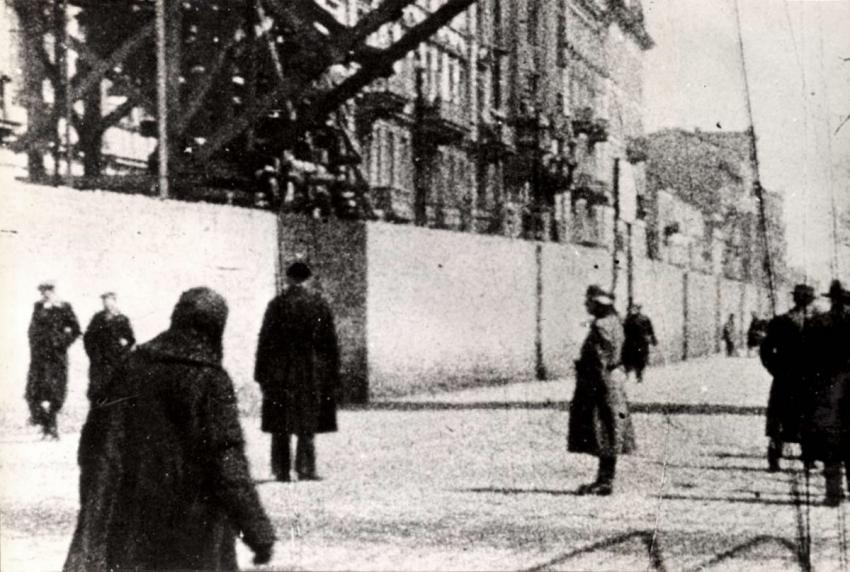In July and August 1942, some 250,000 Jews were deported from the Warsaw ghetto to the Treblinka extermination camp. In January 1943, about one month before this photograph was taken, the Germans wanted to carry out another Aktion and to send a further 8,000 ghetto Jews to the death camps, but encountered armed resistance by the ZOB (Jewish Fighting Organization) and the ZZW (Jewish Military Union).
As a result, the Germans started acting differently during this Aktion. They arrived with tanks, field cannons and heavy artillery. They ceased shouting, and started moving silently. After four days, the Germans halted the Aktion without reaching the deportation quota. From the start, this Aktion was intended to be partial only, but the Jews in the ghetto understood the cessation to be a sign of German weakness and withdrawal in the face of this show of Jewish force. In light of this, many Jews enlisted to the ranks of the resistance in the ghetto.
After the Great Deportation of summer 1942, the resistance organizations started to disseminate pamphlets heralding a departure from a passive stance against the Germans. The resistance of January 1943 clarified to the Germans that from then on, the Jews would not be prepared to leave the ghetto on deportations without resisting.
After January, the incarcerated Warsaw ghetto Jews tried to find new channels of communication with the outside world. They increased their connections with the Polish Underground, sent letters to Jews in other ghettos, and even smuggled themselves out of the ghetto despite the inherent danger. Some of them held positions in the ghetto, such as members of the Ordnungsdienst, some were wealthy, and others were regular Jews. Initially, they searched for Polish acquaintances. Some of those who sneaked out of the ghetto managed to assume a false identity, which helped them to save other Jews by finding hiding places, smuggling, and in other ways. Some Jews paid enormous sums to smugglers and potential "concealers", but didn't succeed in finding a place to hide and were forced to return to the ghetto. Others returned due to the perpetual stress of hiding on the Aryan side and the fear of being caught.
During February and March, the underground organizations in the ghetto performed various acts of sabotage, the last of which, on 13 March, led to the execution of 210 Jews. Despite this, the Jewish Fighting Organization published pamphlets calling for the Jews to ignore German orders, and not to report for deportation. The ZOB and the ZZW assassinated several Germans in the ghetto, and a few Jews who collaborated with the Gestapo, and confiscated money for the purpose of buying arms. Sometimes, gangs of Polish thieves penetrated the ghetto via the wall, and the ghetto underground organizations attempted to fight them.
On 18 March, there was an altercation between the ZOB and armed Germans in the ghetto, but these events were fairly rare. After the resistance of January 1943, the Nazis greatly reduced their involvement in ghetto life. They stopped bringing in soldiers and policemen to carry out deportations, instead bringing in German industrialists to persuade the Jews that the intention behind the deportation was to transport them safely to factories in the Poniatow and Trawniki camps, so that they could work. However, the Jews did not report for transportation. Less than a year later, in November 1944, all the workers in the Poniatow and Trawniki labor camps were murdered – some 43,000 - in the SS Aktion "Erntefest".
Even before the January resistance, the underground organizations in the ghetto worked to smuggle arms in. After January, the Polish resistance in Warsaw responded to the cry for help from the ghetto, and smuggled arms inside. On 2 April, the Polish Underground threw materials to make 100 hand grenades over the ghetto wall. Many weapons crossed the wall from Polish policemen, and even from German policemen: German soldiers who had returned from the eastern front after the defeat at Stalingrad and sold weapons in Warsaw, some of which reached the ghetto.
The January events had a tremendous effect on the preparations for the April Uprising. The success of January's resistance proved to the ghetto inhabitants that they were not helpless, that they could fight back. Thus, many Jews in the ghetto leaned towards supporting the resistance organizations.
Yad Vashem Photo Archives, FA159/B481







